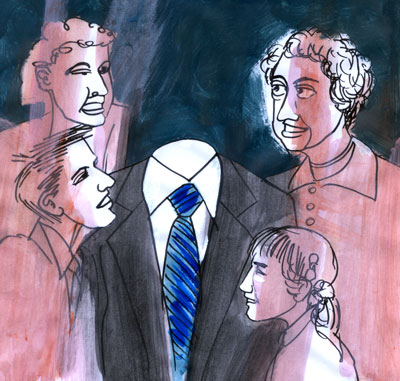 Every Saturday, we’ll be posting a new illustration by David Lester. The Mecca Normal guitarist is visually documenting people, places and events from his band’s 27-year run, with text by vocalist Jean Smith.
Every Saturday, we’ll be posting a new illustration by David Lester. The Mecca Normal guitarist is visually documenting people, places and events from his band’s 27-year run, with text by vocalist Jean Smith.
Frank, a well-respected carpenter—a Broadway star in his own right—had a skill that he turned into real money. He built the sets that the rest of them frolicked on. For Carol, Frank was a relief after the succession of flakes and fools she’d dated. Frank took her to his favorite restaurants—Indian, Ethiopian, French, Spanish—and on weekends, they did things that Carol had planned to do as soon as she moved to New York, but never gotten around to. They went to museums and gardens, the Cloisters, bookstores and jazz clubs, and Frank told her amazing stories that captured her imagination in a way that it had not been captured before.
“There was a guy who used to run a dry cleaner in Greenwich Village,” said Frank. “He came to a restaurant I used to go to, a pizza place really, although I never had the pizza because they burned the crusts and I just don’t think pizza is the thing to have in a restaurant. If I’m going to have pizza, it’s because I’m extremely hungry and pressed for time. Not in a restaurant, no never. Not me.”
Carol laughed at Frank’s strange idea about restaurants and his theory about pizza: when and where it should be consumed. He amused her with his funny stories, and he seemed to enjoy her reaction. And she never questioned him as to whether the things he said were true. There was usually someone doing something absurd, and Frank tended to place the people in a reality they shared—some place in New York that they’d visited together, possibly even that same day—making them believable, in a sleight-of-hand kind of way.
A guy who runs a dry cleaner in Greenwich Village—what’s not to believe? Often times the story didn’t get beyond the character and the setting, before Frank was using what he’d just created as a platform to give his opinion—something that had been bothering him, like the burnt crust of a pizza in a restaurant. How can one mention the crust of another man’s pizza as a significant problem without a construction of some sort to hang it on?
Frank felt compelled to invent just exactly enough of a story to exhibit his assertions, complaints and observations. His creations were like hands on clay as he told Carol, watching her beautifully responsive face; he could increase a certain type of pressure and the clay would rise skyward allowing him to make the contraption tower into a vase or, conversely, if a story faltered, it would end up pressed down into a saucer or a plate.
The truth seemed to be a separate thing to the grandeur of the telling, and since the stories were about people she didn’t know or had never heard of, it didn’t really matter about their truthiness. They were just stories, and Frank seemed to need to tell them. That was the reason for the thing—fun and enjoyment—not in trying to sort out whether these things, the things he talked about, were true. She thought of Frank as a writer without paper, a painter lacking canvas. He needed to make up stories, and it was harmless enough that he told them to her.
Carol was aware that she modified her reactions to the stories based on his expressions, his appreciation of her as the audience, the listener—and, in a way, the subject, too—because while she was busily modifying her reactions to meet his expectations and requirements, he was doing the same thing. Frank was finding out what she liked and bringing those features out—adapting—to create what he thought would please her. All of this was an unarticulated collaboration, and if they’d thought to examine what they were engaged in—accomplishing, honing, inventing—they might have been surprised to see how well they operated together as a team. They might have found a more tactile way to proceed, making something that they could turn in their hands, to assess together, then move on from—that much the wiser. A product of some sort; something to release, promote or manufacture. Neither of them thought in these ways, and so their abilities went entirely unnoticed, especially by them.
If Frank started a story about a princess and he was describing her as rosy cheeked and raven haired, he’d see how that registered across the table in whichever quiet café they were sitting in after visiting a museum or before a night of jazz somewhere mysterious that Frank had found, that he couldn’t wait to show her. If he saw a hint of displeasure that the evening’s protagonist was going to have dark hair, he’d somehow slip that princess out the picture, so fast it would make anyone’s head spin, if they’d been paying attention—and Carol was, and she laughed to prove it.
The raven-haired beauty might suddenly slide from the back of her rearing steed, to be found next morning, drowned, face down in the moat. Carol laughed, and in the blink of an eye, the new princess would be fair and delicate with a crown of golden hair, and Carol would give off favorable signals with her eyes or her fingers, and the story would continue like so. Building. Being built. Together.






